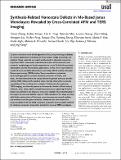| dc.contributor.author | Zhang, Tianyi | |
| dc.contributor.author | Krayev, Andrey | |
| dc.contributor.author | Yang, Tilo H | |
| dc.contributor.author | Mao, Nannan | |
| dc.contributor.author | Hoang, Lauren | |
| dc.contributor.author | Wang, Zhien | |
| dc.contributor.author | Liu, Hongwei | |
| dc.contributor.author | Peng, Yu‐Ren | |
| dc.contributor.author | Zhu, Yunyue | |
| dc.contributor.author | Zheng, Xudong | |
| dc.contributor.author | Isotta, Eleonora | |
| dc.contributor.author | Kira, Maria E | |
| dc.contributor.author | Righi, Ariete | |
| dc.contributor.author | Pimenta, Marcos A | |
| dc.contributor.author | Chueh, Yu‐Lun | |
| dc.contributor.author | Pop, Eric | |
| dc.contributor.author | Mannix, Andrew J | |
| dc.contributor.author | Kong, Jing | |
| dc.date.accessioned | 2025-10-24T15:05:25Z | |
| dc.date.available | 2025-10-24T15:05:25Z | |
| dc.date.issued | 2025-08-08 | |
| dc.identifier.uri | https://hdl.handle.net/1721.1/163385 | |
| dc.description.abstract | 2D Janus transition metal dichalcogenides (TMDs) are promising candidatesfor various applications including non-linear optics, energy harvesting, andcatalysis. These materials are usually synthesized via chemical conversionof pristine TMDs. Nanometer-scale characterization of the obtained Janusmaterials’ morphology and local composition is crucial for both the synthesisoptimization and the future device applications. In this work, we present theresults of cross-correlated atomic force microscopy (AFM) and tip-enhancedRaman spectroscopy (TERS) study of Janus monolayers synthesizedby the hydrogen plasma-assisted chemical conversion of MoSe 2 andMoS2 . We demonstrate that the choice of both the growth substrate and thestarting TMD influences the residual strain, thereby shaping the nanoscalemorphology of the resulting Janus material. Furthermore, by employingTERS imaging, we show the presence of nanoscale islands (≈20 nm across)of MoSe 2 - Mo SSe (MoS2 -MoSeS ) vertical heterostructures originating from thebilayer nanoislands in the precursor monolayer crystals. The understanding ofthe origins of nanoscale defects in Janus TMDs revealed in this study can helpwith further optimization of the Janus conversion process towards uniformand wrinkle-/crack-free Janus materials. Moreover, this work shows thatcross-correlated AFM and TERS imaging is a powerful and accessible methodfor studying nanoscale composition and defects in Janus TMD monolayers. | en_US |
| dc.language.iso | en | |
| dc.publisher | Wiley | en_US |
| dc.relation.isversionof | https://doi.org/10.1002/smll.202504742 | en_US |
| dc.rights | Creative Commons Attribution | en_US |
| dc.rights.uri | https://creativecommons.org/licenses/by/4.0/ | en_US |
| dc.source | Wiley | en_US |
| dc.title | Synthesis‐Related Nanoscale Defects in Mo‐Based Janus Monolayers Revealed by Cross‐Correlated AFM and TERS Imaging | en_US |
| dc.type | Article | en_US |
| dc.identifier.citation | T. Zhang, A. Krayev, T. H. Yang, et al. “ Synthesis-Related Nanoscale Defects in Mo-Based Janus Monolayers Revealed by Cross-Correlated AFM and TERS Imaging.” Small 21, no. 37 (2025): 21, 2504742. | en_US |
| dc.contributor.department | Massachusetts Institute of Technology. Department of Electrical Engineering and Computer Science | en_US |
| dc.relation.journal | Small | en_US |
| dc.eprint.version | Final published version | en_US |
| dc.type.uri | http://purl.org/eprint/type/JournalArticle | en_US |
| eprint.status | http://purl.org/eprint/status/PeerReviewed | en_US |
| dc.date.updated | 2025-10-24T15:00:12Z | |
| dspace.orderedauthors | Zhang, T; Krayev, A; Yang, TH; Mao, N; Hoang, L; Wang, Z; Liu, H; Peng, Y; Zhu, Y; Zheng, X; Isotta, E; Kira, ME; Righi, A; Pimenta, MA; Chueh, Y; Pop, E; Mannix, AJ; Kong, J | en_US |
| dspace.date.submission | 2025-10-24T15:00:21Z | |
| mit.journal.volume | 21 | en_US |
| mit.journal.issue | 37 | en_US |
| mit.license | PUBLISHER_CC | |
